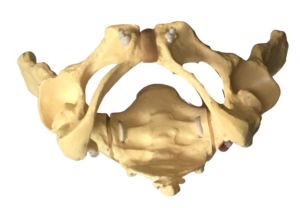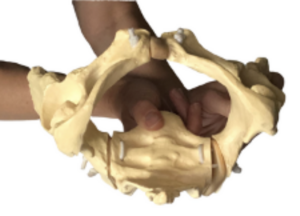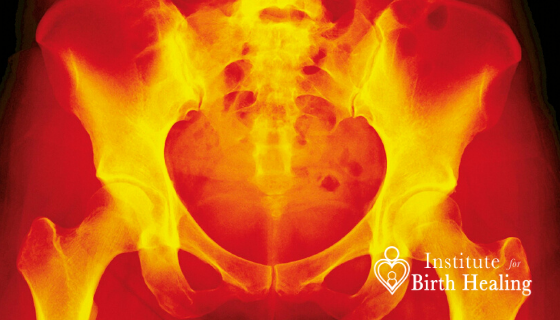Sitting Funny or Feel Like Your Pelvis Is A Little Off?
Realigning Your Pelvis – Ischia
Do things seem a little off down there – in your pelvis? You feel like you are sitting funny? Adding a newborn can throw anyone off but this is an “in my body offness”. (I’m creating new words here; do you like it?)
Well, it’s probably because you are.
In working with thousands of postpartum women I’ve seen how birth can create an uneven base in your body, that base is your pelvis. So many women have problems in their body whether it be incontinence, prolapsing of pelvic organs, general weakness in your body or a sense of feeling off, or they can have their pelvis stuck in an open birthing position.

Birth Response in the Pelvis
When the baby passes through your pelvis the sit bones expand out to the side as the baby comes out.
Now looking at that pelvic ring you would think the baby can only come out centrally and evenly, but that’s not always the case. It would be nice if it was, but unfortunately, I see hundreds of women with one ischium or sit bone, splayed out more than the other. Or both of the ischia are stuck splayed out, still in the birthing position. This creates an uneven, ungrounded, or off-balanced feeling in your body, especially when you are sitting. You could al have an ischium out of position and not feel anything at all until maybe you go to stretch your hamstrings or some other weird little feeling around your hips or buttocks.


Is this you?
I recently worked on both of my aunts and they both had this issue. One aunt has a 26-year-old daughter who is the youngest of her 3 children. She was complaining of feeling a pulling, pain deep in her left hip only when she stretched her hamstring on that side. The other side felt fine. Knowing the hamstrings main attachment is to the ischium I checked to see what hers were doing. Her left ischium was more splayed out to the side than the right. When I helped it find it’s way back to its normal position my aunt was able to stretch her hamstring again without any pain in her hip.
When asked about her births she reported they all were short, “easy” and less than 7 hours. Notice I put easy in quotations there! But it’s not like she was pushing for hours on end and she still has this issue, 26 years later! Since I see women who are having bigger issues after birth, usually I find this asymmetry in women who’ve been pushing for 2+ hours. This made me even more concerned that this could be an effect of ANY birth!
My other aunt who’s oldest is 47 years old, had both of her ischia splayed way out to the side. She’s been living in this state for 47 years! When asked about her 3 births she reported the first one took a long time and she pushed for several hours. It was a rough one, she said! It felt like her body never really completed that birth. When we got done with her treatment and had brought her ischia back together she realized how grounded she felt. It was like her body could finally stop doing something and just be, something this aunt has had a hard time doing in her life!
Other women, I’ve seen in my practice complain of not feeling even when sitting and not feeling balanced in their body. Then after the treatment, they have a greater sense of balance in their pelvis, able to sit more evenly and there is ease in their body again.
Realigning Your Ischia
Bringing the pelvis back to midline again is a relatively easy thing to do but not everyone is looking for it or can sense what the bones are doing. Using touch and tuning into the bones, my hands can sense the energy of the birth pattern and feel what the bones are doing energetically. When all is good the bones are neutral and there is no movement noted, yet when there is a pattern in there they move into that pattern when you tune into it. There is an outward force of energy in the bone when it is still playing out from birth. I don’t know of any other motion that we do with our body that would cause this outward splay of the ischia other than birth. A fall may be a close contributor but most impacts send the ischia inward and not outward. Maybe a fall onto a hard object with the object hitting between the sit bones, but not many people have that experience, thankfully!
When this splaying out energy is felt, it’s just a matter of helping the bones to remember that the birth is over and they can stop pushing outward and come inward again. I assess this in a sitting position, having my client sit on a two-inch foam padded bench. With my palms of my hands under their ischia, I can feel if one is heavier than the other, more forward or more out to the side. Sometimes there is an oblique positioning of the bone, forward and out to the side.
When teaching this to a group of midwives and birth professionals we found that just having several people feel into what the bones wanted to do, without trying to treat them, helped them shift back into place. So if you are a health practitioner, you can feel for yourself how your client is sitting and how even the pressure is under your hands. When you become aware of the pattern you can encourage the bones to find their midline directly under your client. Gentle force is all that is needed when coupled with intention.
Self-help for your pelvis?
Give this a try your self but if you aren’t experiencing any significant changes please see one of my birth healing specialists. You can try sitting on a couch and place your hands under your sits bones and see what you can feel. If you are newly postpartum, within that couple of months, your bones are more supple and may respond nicely to just intentional guidance to find their way back home. If it’s been longer than a year, it may just take more time to get them to adjust. You can also have your partner see what they can feel.
Making sure you are sitting as evenly as possible, place your hands under your sits bones. Try and get the same portion of both hands under the sits bones. See what you can feel with your hands. Do you find one bone heavier in your hand than the other? You want to feel the same pressure and direction of the bone in each hand. See if you can sense what the lighter feeling bone wants to do? Does it feel more forward or backward than the other, more out to the side than the other? If so, encourage it to become like the other bone. Sometimes by making the two sides aware of each other, left side feel what the right side feels like and vice-versa, we can get them to shift to be like each other.
You can also try feeling your sit bones while laying down on your back with your knees bent up. Have your hands feel for your sit bones and just touch into them. Encourage them to find their home more together in the midline. See if you can feel a softening happening to the bones. This is a sign they are settling back into place.
Your partner can help you bring your bones back together. Have them slide their hands under your bottom and under your waist. At the waist, there are two bumps of bones that they should try squeezing together. The other hand should find your sit bones under your gluteal muscles and work to squeeze them together as well. This is best done with your knees bent up. Hold the squeeze until you feel a softening of the tissues. You breathing into the tissues can help as well.
Getting your ischial bones back in place underneath you allows for a greater sense of balance, groundedness, and peace in your body and your life. Plus sitting is much more comfortable!
Check it out and let me know how this works for you!

